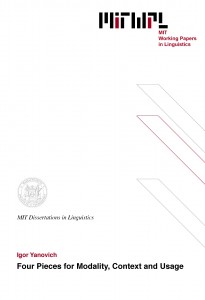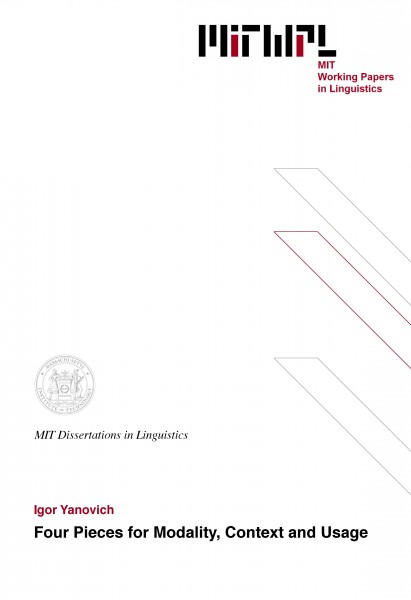The Tonal Phonology of Chinese
M. J. W. Yip, 1980
This study sets out to construct a fully articulated theory of the phonology of tone, encompassing both the formal properties of tonal rules, and a feature system for tone. To counter-balance the African bias of earlier work, data are drawn mainly from Chinese and other East Asian languages. The first portion contains evidence that tone is autosegmental in Chinese languages as it is in African languages: the phenomena of stability, floating tones and toneless morphemes are shown to exist in Mandarin, Shanghai, Cantonese and Amoy. This is followed by a demonstration of the close relationship between tone and other prosodic phenomena such as stress and metrics.
The second portion constructs a binary feature system for tone based on two hierarchically organized features, each of which is autosegmental. Historical, typological and synchronic evidence are used to show that this system solves several long-standing problems in the study of tone.
The final portion includes a detailed analysis of the tonology of five languages – Mandarin, Cantonese, Shanghai, Amoy and Fuzhou – within the framework developed in the earlier sections.
Thesis supervisor: Morris Halle
Title: Ferrari P. Ward Professor of Modern Languages and Linguistics
Table of Contents
Introduction 8
0.1 The nature of the problem 10
0.2 Approaches to the problem 16
0.3 The choice of a suprasegmental theory 20
0.4 Notation, romanization, and other trivia 30
0.5 Tone in Chinese: the autosegmental evidence 35
0.6 A feature system for tone 44
0.7 Some formal properties of the system 51
Chapter 1 Arguments for an autosegmental analysis of Chinese languages 60
1.1 Segmentless morphemes 60
1.1.1 Cantonese changed tone 60
1.1.2 Mandarin reduplication 66
1.1.3 Amoy triple reduplication 75
1.2 Toneless morphemes 79
1.2.1 Mandarin suffixes 79
1.2.2 Southern Min neutral tone 83
1.3 Deletion of segments only 87
1.3.1 Cantonese changed tone 87
1.3.2 Amoy contraction 91
1.4 Deletion of tone only 94
1.4.1 Mandarin neutral tone 94
1.4.2 Shanghai word tone 97
1.4.3 Amoy a53 suffix 99
1.5 Spreading 102
1.6 Segmental tone in Zahao? 104
1.7 A dynamic tone theory 116
1.7.1 A brief summary of dynamic tone theory 116
1.7.2 Problems stemming from the choice of dynamic primitives 126
1.7.3 Problems stemming from the positioning of tone markers
among the segmentals 135
Notes to Chapter 1 142
Chapter 2 Interaction of tone and other prosodies 144
2.1 Tone and stress 144
2.1.1 Mandarin 144
2.1.2 Amoy 157
2.1.3 Shanghai 163
2.2 Traditional Chinese verse 166
2.2.1 A metrical analysis 166
2.2.2 Neutral tone in Min 175
2.2.3 Deviations from the canon: the free positions 179
2.2.4 Tone assignment 186
Notes to Chapter 2
Chapter 3 An introduction to the concept of register 195
3.1 A summary 195
3.2 Typological considerations 198
3.2.1 Five-tone languages 202
3.2.2 Three contour tone languages 204
3.2.3 Downstep and other matters 207
3.3 Historical evidence 211
3.3.1 Why other systems fail 211
3.3.2 Voicing – necessary but not sufficient condition for
register development 216
3.3.3 Mandarin and Cantonese tonal splits 223
3.4 The physiology of pitch control 242
Notes to Chapter 3 246
Chapter 4 The autosegmental nature of register 250
4.1 Partial morphemes 250
4.1.1 Morphemes lacking one level only 251
4.1.2 Morphemes lacking two levels 255
4.2 Partial deletion 261
4.2.1 Deletion on one level only 261
4.2.2 Deletion on more than one level 267
4.3 Spreading 272
4.4 The domain of register and tone 273
Notes to Chapter 4 282
Chapter 5 Summaries of the tonal phonology of various languages 283
5.1 Mandarin 283
5.2 Shanghai 300
5.3 Amoy 319
5.4 Fuzhou 337
5.5 Cantonese 356
Notes to Chapter 5 359

